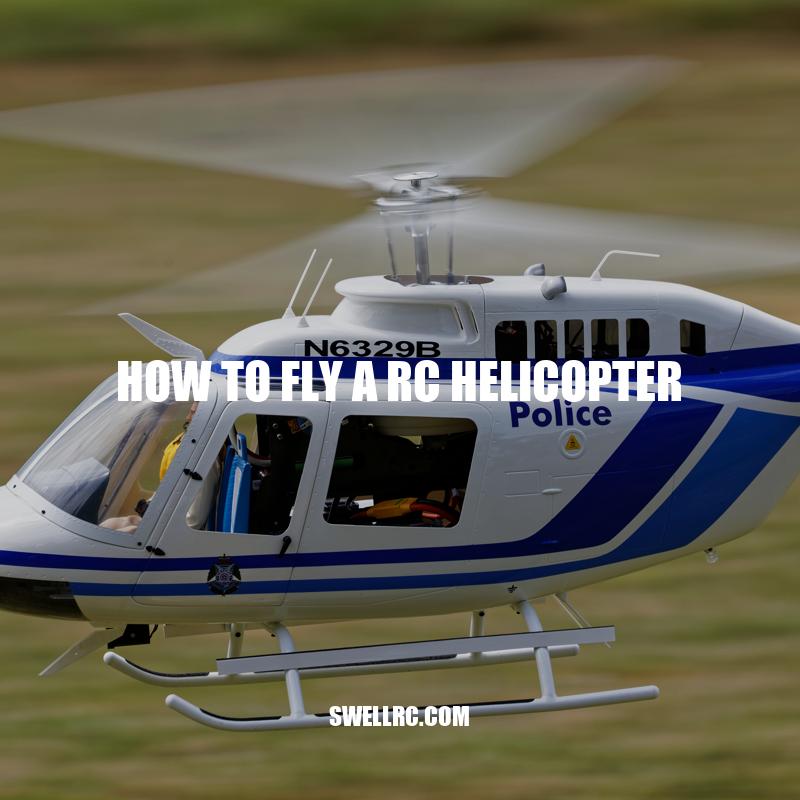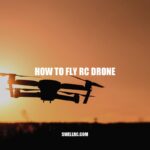Mastering the Basics: How to Fly an RC Helicopter
Remote-controlled helicopters, also known as RC helicopters, are becoming increasingly popular among hobbyists of all ages. These miniature flying machines come in various shapes, sizes, and models, and offer endless entertainment for those that enjoy a challenge. Unlike the simpler remote-controlled planes, RC helicopters require a great deal of skill, patience, and practice to master. The basics on how to fly a RC helicopter can be covered in a few paragraphs, but it takes time and effort to become a skilled pilot. So, if you are interested in learning how to fly a RC helicopter, buckle up and get ready to embark on a thrilling learning journey. This article will cover the fundamental steps on how to fly a RC helicopter safely and effectively, from basic parts and functions to advanced maneuvers and stunts.
Remote Control Basics
To get started, it’s important to familiarize yourself with the remote control of your RC helicopter. Here are a few basic tips to keep in mind:
- Throttle Stick: Controls the altitude of the RC helicopter. Push the stick up to take off and gain altitude, and pull it down to descend and land.
- Aileron Stick: Controls the helicopter’s roll and movement from left to right.
- Elevator Stick: Controls the pitch of the helicopter’s nose and movement from front to back.
- Rudder Stick: Controls the direction of the helicopter.
Make sure to read the instruction manual carefully to understand your specific helicopter’s remote and functions. You may want to consider purchasing an animated training product or software to help you learn the ropes. Some helpful training resources include:
- RC Flight School: Offers training kits, seminars, and instructional videos for all skill levels.
- RealFlight: A popular flight simulation software that helps you practice your flying skills on your computer.
- Heli Flight Center: Provides online tutorials, tips, and information on various aspects of RC helicopter flying.
How do you steer a RC helicopter?
To steer an RC helicopter, you will need to use a transmitter that sends signals to the helicopter’s receiver. The transmitter has control sticks that can move up, down, left, and right to control the helicopter’s movements.
Here’s a breakdown of the different control sticks and what they do:
- Left stick (throttle/collective): Controls the helicopter’s altitude by adjusting the rotor speed.
- Right stick (cyclic/rudder): Controls the helicopter’s direction by tilting the rotor blades.
- Trim buttons: Used to fine-tune the helicopter’s movements and keep it stable.
It takes practice to become proficient at flying an RC helicopter, but with time and dedication, you can become an expert.
For more information on RC helicopter flying tips and techniques, check out websites like RC Groups and products like the Syma S107G RC Helicopter.
Pre-flight Checklist
Before taking off, it’s important to ensure that your RC helicopter and remote control are working properly. Here is a pre-flight checklist to help you get started:
| Checklist Items | Step-by-Step |
|---|---|
| Battery Installation: Make sure the battery is properly installed and charged. | Refer to the instruction manual for proper installation and charging instructions. |
| Control Surfaces: Check that all control surfaces and rotor blades are properly attached and tightened. | Manually inspect each part to ensure its proper attachment |
| Transmitter Settings: Ensure that the transmitter is set to the appropriate settings, and check the trim settings for each control. | Review the manual on how to adjust the settings for your specific model and review the trim settings for each control. |
Remember that safety should always be the top priority when flying RC helicopters. It’s important to also check for any potential hazards in the flying area such as trees, power lines, or obstacles. Always fly in a designated area and respect other people’s property and privacy.
How do I know if my RC helicopter is charging?
To check if your RC helicopter is charging, follow these steps:
- Look for a light on the charging cable: The charging cable usually has a light that indicates when the helicopter is charging. If the light is on, then the helicopter is charging.
- Check the battery level: Sometimes the helicopter’s battery level indicator can show if it is charging or not. Check the manual for how to read the battery level indicator.
- Look for an audio cue: Some chargers have audio cues that indicate the helicopter is charging, such as a beep or a sound. Check the manual for any audio cues.
If you’re still not sure, refer to your RC helicopter’s manual or contact the manufacturer for specific instructions. You can also find helpful tips and troubleshooting advice on RC hobbyist websites like RCGroups.com or RCPlanet.com.
Beginning Flight Operations
Before becoming an expert in flying an RC helicopter, it’s important to start with the basics. Here are a few tips for beginning flight operations:
- Start Slow: Begin flying at a low altitude and speed to get a feel for the helicopter and remote control.
- Practice Hovering: Practice hovering the helicopter above the ground to maintain control and stability.
- Control Stick Functions: Understand the functions of each control stick on the remote and how they affect the movement of the helicopter.
One helpful resource for beginners is the Academy of Model Aeronautics website. This website provides useful information for hobbyists interested in radio-controlled aircraft, including safety guidelines, flying tips, and resources on finding and joining local flying clubs. Additionally, there are various training programs and simulators available to help beginners learn how to fly RC helicopters. By practicing regularly and being patient, you can become a skilled RC helicopter pilot in no time!
What should I do for an introductory flight?
If you’re thinking about taking an introductory flight, here are a few things to keep in mind:
- Choose a reputable flight school or instructor. Look for reviews online to see what other students have to say.
- Dress appropriately for the weather and make sure you wear comfortable shoes.
- Arrive early so you have time to check in and complete any necessary paperwork.
- Listen carefully to the instructor’s briefing and ask questions if you’re unsure about anything.
- Enjoy the experience and take in the sights!
If you’re interested in finding flight schools or instructors in your area, websites like LearnToFlyHere.com or PilotSchools.com can be helpful resources.
Basic Movements and Maneuvers
Once you’ve mastered the basics of RC helicopter flight, you can move on to learning basic movements and maneuvers. Here are few to try out:
- Forwards and Backwards: Push the right control stick forwards or backwards to make the helicopter move in the corresponding direction.
- Sideways: Push the right control stick to the left or right to make the helicopter move in that direction.
- Turning and Rotating: Push the left control stick left or right to turn the helicopter, or spin the control stick in a circular motion to make the helicopter rotate in the air.
It’s important to practice these basic movements to become comfortable with controlling the helicopter in different directions. Additionally, there are various resources online that offer more advanced techniques and maneuvers such as inverted flight, flips, and aerobatics. One such resource is the RC-Helicopter-School website, which provides tips and techniques for becoming a skilled RC helicopter pilot. By continuing to practice and expand your skill set, you can become a master of the RC helicopter!
How does RC helicopter work?
RC helicopters are a fun and exciting hobby for many people. The basic principles of how they work are relatively simple:
- Rotors – The main rotor is the main lifting force for the helicopter, while the tail rotor provides directional control.
- Electric Motor – The electric motor powers the rotors and allows the helicopter to take off and fly.
- Battery – The battery powers the electric motor and is typically rechargeable.
- Remote Control – The remote control allows the pilot to control the movement of the helicopter through the air.
If you’re interested in purchasing an RC helicopter, there are many websites and products available online. Do your research to find the right one for your skill level and interests.
Advanced Movements and Maneuvers
Once you’ve become comfortable performing basic movements and maneuvers with your RC helicopter, you can explore more advanced techniques. Below are some examples of these:
- Inverted Flight: Flying the helicopter upside down or on its roof.
- Flips: Performing a loop in the air by quickly rolling the helicopter 360 degrees.
- Aerobatics and Stunts: Mastering more advanced movements and techniques such as rolls, loops, and stall turns.
It’s crucial to practice these challenging maneuvers in a safe and controlled environment, such as a designated RC helicopter flying area. Also, investing in a quality helicopter and remote control can make these maneuvers easier to achieve. One such helicopter is the Blade 230S helicopter, which features advanced flight control software and a durable frame that can withstand crashes during advanced flight techniques. By gradually building up your skills and experimenting with new techniques, you can become a confident and skilled RC helicopter pilot.
What are the maneuvers of helicopter?
Helicopters are extremely versatile aircraft that can perform various maneuvers. Some of the most common helicopter maneuvers include:
- Hovers
- Forward flight
- Turns
- Hovering turns
- Vertical climbs and descents
- Auto-rotations (controlled descent without engine power)
If you’re interested in learning more about helicopter maneuvers, there are many online resources and training programs that can provide detailed information and instruction. One such resource is the Helicopter Online Ground School, which offers courses covering all aspects of helicopter operations.
Safe and Responsible Flying
It’s essential to prioritize safety when flying an RC helicopter. Not only can this help prevent damage to your helicopter, but it can also prevent accidents and injuries. Below are some tips to keep in mind when flying:
- Keep Your Distance: Maintain a safe distance from other people, animals, and objects when flying.
- Follow Regulations: Familiarize yourself with local and federal regulations on RC helicopter flying and adhere to them at all times.
- Flying in Designated Areas: Only fly in designated RC helicopter flying areas that are safe and legal for use.
- Proper Maintenance and Repair: Regularly check and maintain your helicopter to ensure it’s in good working condition. In case of damage or repairs, ensure that you use original parts from the manufacturer.
Conclusion
Flying an RC helicopter can be an incredibly rewarding and enjoyable experience. By understanding the basics of flight and gradually building up your skills, you can become a skilled RC helicopter pilot. However, it’s essential to prioritize safety and responsibility when flying. By following regulations, maintaining your helicopter properly, and flying in designated areas, you can ensure an enjoyable and safe flying experience for everyone involved.



